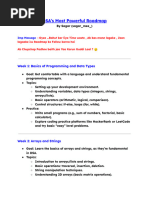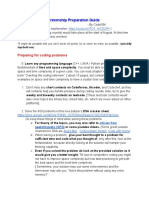Roadmap for Data scrutures and Algorithms
Uploaded by
thansheerbhrRoadmap for Data scrutures and Algorithms
Uploaded by
thansheerbhrThanks for the clarification!
Since you have 3 months and already have a
solid grasp of Machine Learning concepts like linear regression,
cross-validation, confusion matrix, Lasso, polynomial regression,
and others, the focus will be on sharpening your DSA skills (to tackle
coding interviews), deepening your ML knowledge, and preparing you for
both technical and behavioral rounds.
Here's a detailed 3-month interview prep roadmap:
Month 1: Master Data Structures & Algorithms (DSA)
Since you already know some DSA concepts, this month will focus on
revision and intensive practice of problem-solving. The goal is to get
comfortable solving problems efficiently and within time constraints.
Week 1–2: Revision of Core DSA Topics
Focus Areas:
• Arrays: Sliding window, two-pointer technique, prefix sums, subarrays.
• Strings: Pattern matching, anagram checks, substring search, and
common string algorithms (KMP, Rabin-Karp).
• Linked Lists: Reverse, detect cycle, merge two lists, find middle.
• Stacks & Queues: Implementations, balanced parentheses, and design
questions.
• Hashing: Hash map, hash set problems (frequency count, finding
duplicates).
• Trees: In-order, pre-order, post-order traversal, BST operations (insert,
delete), height of a tree, lowest common ancestor (LCA).
• Graphs: BFS, DFS, shortest path algorithms (Dijkstra, Bellman-Ford),
topological sort, cycle detection.
• Dynamic Programming: Solve problems like Fibonacci, Knapsack, Coin
Change, Longest Increasing Subsequence (LIS), subset sum.
Recommended Resources:
• LeetCode (focus on easy/medium problems)
• GeeksforGeeks (practice from their interview questions list)
• Cracking the Coding Interview: Work through problems from this book,
focusing on arrays, strings, linked lists, and trees.
Key Practice:
• Solve 3-5 problems daily on LeetCode, focusing on understanding the
optimal solutions and the time/space complexity.
• Focus on time complexity and space complexity for each problem to
master Big-O notation.
Week 3–4: Advanced DSA Concepts & Mock Interviews
Once you’re comfortable with the basics, you need to focus on advanced
topics and time management.
Focus Areas:
• Advanced Trees: AVL trees, Binary Search Tree (BST) problems, range
queries.
• Heaps: Priority queues, heapify, merge k sorted lists, heap sort.
• Backtracking: N-Queens, Sudoku solver, permutation generation.
• Graph Algorithms: Dijkstra's algorithm, Bellman-Ford, Floyd-Warshall,
Union-Find, Kruskal’s/Prim’s algorithm.
• Bit Manipulation: XOR operations, finding odd/even, flipping bits,
swapping two numbers.
Practice:
• Solve 2-3 hard problems on LeetCode or Codeforces daily, focusing
on complexity optimization and correctness.
• Use platforms like Pramp or Interviewing.io to schedule mock coding
interviews (practice thinking aloud and coding under time pressure).
Resources:
• LeetCode: Focus on hard level problems as you grow more confident.
• Cracking the Coding Interview (Advanced sections).
• GeeksforGeeks: Advanced DSA problems (graphs, dynamic
programming, etc.).
Month 2: Dive Deeper into ML and Prepare for ML
Interview Questions
In this month, you’ll leverage your existing ML knowledge and push
deeper into topics that are often asked in interviews.
Week 1: Core ML Concepts (Reinforcement)
You already know the basics, so now you need to refine your
understanding and problem-solving skills in the following areas:
Key Topics:
• Linear Regression & Logistic Regression (Understanding the
mathematics behind them, assumptions, and use cases).
• Regularization: Lasso, Ridge, and ElasticNet regression. Bias-variance
tradeoff.
• Classification Metrics: Precision, recall, F1-score, ROC curves, and AUC.
• Overfitting vs. Underfitting: Model selection, bias-variance tradeoff,
cross-validation.
• Gradient Descent: Understanding the optimization process (Stochastic
Gradient Descent, Mini-Batch).
Practice:
• Implement and optimize regression models and classification models
from scratch.
• Work with real-world datasets to solve problems like house price
prediction, classification problems, etc.
Resources:
• Coursera: Andrew Ng’s Machine Learning course (to brush up on core
concepts).
• Hands-On Machine Learning with Scikit-Learn, Keras, and
TensorFlow by Aurélien Géron.
Week 2–3: Advanced ML Topics
Focus on advanced ML algorithms and the theory behind them. In
interviews, you may be asked about more complex methods and their
applications.
Key Topics:
• Decision Trees: Gini index, entropy, pruning.
• Ensemble Methods: Random Forests, Gradient Boosting (XGBoost,
LightGBM).
• Clustering: K-means, hierarchical clustering.
• Dimensionality Reduction: PCA, t-SNE.
• Neural Networks Basics: Perceptrons, multi-layer neural networks,
backpropagation.
Practice:
• Work on Kaggle competitions to apply these models on real datasets
and understand their performance.
• Solve interview-style questions on machine learning, such as:
◦ How do you handle imbalanced datasets?
◦ How do you select features for a model?
◦ How would you evaluate a classification model?
Resources:
• Kaggle: Participate in beginner-level competitions.
• ML Interview Questions: Use resources like "Machine Learning
Yearning" by Andrew Ng.
Week 4: NLP and ML in Interviews
Given the strong demand for NLP roles, it’s worth understanding key
concepts, even if it’s just for awareness in case they come up during
interviews.
Key Topics:
• Text Preprocessing: Tokenization, stopwords, stemming, lemmatization.
• TF-IDF and Bag of Words: Text vectorization techniques.
• Word Embeddings: Word2Vec, GloVe.
• Basic NLP Tasks: Text classification, Named Entity Recognition (NER),
sentiment analysis.
Practice:
• Build a simple text classification model.
• Use spaCy or NLTK for basic NLP tasks.
Resources:
• Coursera: Natural Language Processing Specialization by deeplearning.ai.
• Kaggle: NLP challenges like Sentiment Analysis, Spam Email
Detection.
Month 3: System Design, Mock Interviews, & Behavioral
Prep
Week 1: System Design Basics
Though system design isn’t a priority in many early-stage interviews,
companies like FAANG often include system design rounds. Get a feel for
common design patterns and practice scalable system design.
Key Topics:
• Design Patterns: Client-server architecture, caching, load balancing.
• Databases: SQL vs. NoSQL, CAP theorem, database sharding.
• Scalability: Horizontal vs. vertical scaling, microservices architecture.
Practice:
• Design a URL shortening service (like Bit.ly).
• Design a file storage system.
• Design a messaging system (e.g., WhatsApp).
Resources:
• System Design Interview by Alex Xu.
• YouTube Channels like Gaurav Sen for system design walkthroughs.
Week 2–3: Mock Interviews and Time Management
It’s time to simulate actual interviews to get comfortable with the process.
Focus Areas:
• Solve coding problems under time pressure.
• Practice explaining your approach and solution clearly.
• Focus on edge cases, optimization, and complexity.
Mock Interview Platforms:
• LeetCode mock interviews.
• Pramp or Interviewing.io for live coding interviews.
• Peer Mock Interviews: Pair up with a friend to do mock interviews.
Week 4: Behavioral Interview Prep
Focus on preparing for behavioral interview questions, which are often
just as important as technical ones.
Key Questions:
• Tell me about a time you handled a difficult situation.
• How do you prioritize tasks in a project?
• What is your greatest achievement in your career?
Preparation:
• Use the STAR method (Situation, Task, Action, Result) to structure your
answers.
• Practice with a mentor or peer.
Resources:
• "Cracking the Coding Interview" for common behavioral questions.
Final Week: Final Mock Interviews & Relaxation
• Mock Interviews: Schedule final rounds of mock technical and
behavioral interviews.
• Rest: Take 1–2 days to rest before your interviews to ensure you’re
mentally sharp.
Summary of Timeline (3 months)
1 Month 1: Master DSA and problem-solving (with daily practice).
2 Month 2: Focus on ML topics, advanced algorithms, and **
NLP** basics. 3. Month 3: Prepare for System Design, complete mock
interviews, and polish behavioral skills.
This should set you up for success in both coding interviews and
machine learning/nlp roles.
Let me know if you want further adjustments to the roadmap!
You might also like
- Pvsyst Tutorial v7 Pseudo Sub Hourly enNo ratings yetPvsyst Tutorial v7 Pseudo Sub Hourly en15 pages
- Best 4000 Smart Question Bank Banking Reasoning Ability in English Next Generation Smartbook by Testbook and S Chand 4705ded0100% (1)Best 4000 Smart Question Bank Banking Reasoning Ability in English Next Generation Smartbook by Testbook and S Chand 4705ded03 pages
- ML_Engineer_Roadmap_2024_Abdullah_Al_Mamun (1)No ratings yetML_Engineer_Roadmap_2024_Abdullah_Al_Mamun (1)6 pages
- Python_FullStack_AI_ML_Roadmap_PresentationNo ratings yetPython_FullStack_AI_ML_Roadmap_Presentation6 pages
- Machine Learning QnA Session @ DDU Jan 2025No ratings yetMachine Learning QnA Session @ DDU Jan 20256 pages
- 0 To 1 Path To Become A Master Coder: Tathastu RoadmapsNo ratings yet0 To 1 Path To Become A Master Coder: Tathastu Roadmaps14 pages
- The (Almost) Complete Machine Learning Roadmap: Milestone 0: Python 3 and Other Basic StuffNo ratings yetThe (Almost) Complete Machine Learning Roadmap: Milestone 0: Python 3 and Other Basic Stuff5 pages
- 6-Month Roadmap to Becoming an AI Engineer_ a Step-By-Step GuideNo ratings yet6-Month Roadmap to Becoming an AI Engineer_ a Step-By-Step Guide20 pages
- Interview Preparation For Data ScientistsNo ratings yetInterview Preparation For Data Scientists5 pages
- 3 month Roadmap to 30 lacs- yr - Pratham KohliNo ratings yet3 month Roadmap to 30 lacs- yr - Pratham Kohli4 pages
- Python/C++/R/Java: If You Want A Job in MachineNo ratings yetPython/C++/R/Java: If You Want A Job in Machine3 pages
- Internship Preparation Guide (By CodeISM)No ratings yetInternship Preparation Guide (By CodeISM)7 pages
- data science course training in india hyderabad: innomatics research labsFrom Everanddata science course training in india hyderabad: innomatics research labsNo ratings yet
- Yokouchi - 2023 - PRL - Giant Magnetochiral Anisotropy in Weyl Semimetal (WTe2) Induced by Diverging Berry CurvatureNo ratings yetYokouchi - 2023 - PRL - Giant Magnetochiral Anisotropy in Weyl Semimetal (WTe2) Induced by Diverging Berry Curvature6 pages
- The Correct Methodology To Re-Establish The Islamic State (Urdu PDFNo ratings yetThe Correct Methodology To Re-Establish The Islamic State (Urdu PDF89 pages
- SIMEK Tangible Religion - Amulets, Illnesses, and The Demonic Seven SistersNo ratings yetSIMEK Tangible Religion - Amulets, Illnesses, and The Demonic Seven Sisters22 pages
- Cisco Unified Real-Time Monitoring Tools Admin GuideNo ratings yetCisco Unified Real-Time Monitoring Tools Admin Guide284 pages
- Who s Doing the Work How to Say Less So Readers Can Do More 1st Edition Jan Burkins Kim Yaris - Discover the ebook with all chapters in just a few seconds100% (3)Who s Doing the Work How to Say Less So Readers Can Do More 1st Edition Jan Burkins Kim Yaris - Discover the ebook with all chapters in just a few seconds65 pages
- Dialnet MalaysianPerceptionsOfChina 1210502 PDFNo ratings yetDialnet MalaysianPerceptionsOfChina 1210502 PDF13 pages
- Real Country Experiences: On-Line Teaching in Wartime After Pandemic in UkraineNo ratings yetReal Country Experiences: On-Line Teaching in Wartime After Pandemic in Ukraine12 pages
- Powerbuilder Enterprise: Installation GuideNo ratings yetPowerbuilder Enterprise: Installation Guide42 pages
- Name of Experiment:: Study of Logic GatesNo ratings yetName of Experiment:: Study of Logic Gates7 pages
- On The Riemann Hypothesis - Gerasimos PergarisNo ratings yetOn The Riemann Hypothesis - Gerasimos Pergaris27 pages
- Kami Export - Alvaro Andre Robles Tipte - WB Unit 9No ratings yetKami Export - Alvaro Andre Robles Tipte - WB Unit 98 pages
- A.W. Barber Calgary University Department of Religious Studies0% (1)A.W. Barber Calgary University Department of Religious Studies23 pages
- Best 4000 Smart Question Bank Banking Reasoning Ability in English Next Generation Smartbook by Testbook and S Chand 4705ded0Best 4000 Smart Question Bank Banking Reasoning Ability in English Next Generation Smartbook by Testbook and S Chand 4705ded0
- 0 To 1 Path To Become A Master Coder: Tathastu Roadmaps0 To 1 Path To Become A Master Coder: Tathastu Roadmaps
- The (Almost) Complete Machine Learning Roadmap: Milestone 0: Python 3 and Other Basic StuffThe (Almost) Complete Machine Learning Roadmap: Milestone 0: Python 3 and Other Basic Stuff
- 6-Month Roadmap to Becoming an AI Engineer_ a Step-By-Step Guide6-Month Roadmap to Becoming an AI Engineer_ a Step-By-Step Guide
- data science course training in india hyderabad: innomatics research labsFrom Everanddata science course training in india hyderabad: innomatics research labs
- Yokouchi - 2023 - PRL - Giant Magnetochiral Anisotropy in Weyl Semimetal (WTe2) Induced by Diverging Berry CurvatureYokouchi - 2023 - PRL - Giant Magnetochiral Anisotropy in Weyl Semimetal (WTe2) Induced by Diverging Berry Curvature
- The Correct Methodology To Re-Establish The Islamic State (Urdu PDFThe Correct Methodology To Re-Establish The Islamic State (Urdu PDF
- SIMEK Tangible Religion - Amulets, Illnesses, and The Demonic Seven SistersSIMEK Tangible Religion - Amulets, Illnesses, and The Demonic Seven Sisters
- Cisco Unified Real-Time Monitoring Tools Admin GuideCisco Unified Real-Time Monitoring Tools Admin Guide
- Who s Doing the Work How to Say Less So Readers Can Do More 1st Edition Jan Burkins Kim Yaris - Discover the ebook with all chapters in just a few secondsWho s Doing the Work How to Say Less So Readers Can Do More 1st Edition Jan Burkins Kim Yaris - Discover the ebook with all chapters in just a few seconds
- Real Country Experiences: On-Line Teaching in Wartime After Pandemic in UkraineReal Country Experiences: On-Line Teaching in Wartime After Pandemic in Ukraine
- Kami Export - Alvaro Andre Robles Tipte - WB Unit 9Kami Export - Alvaro Andre Robles Tipte - WB Unit 9
- A.W. Barber Calgary University Department of Religious StudiesA.W. Barber Calgary University Department of Religious Studies

























































































